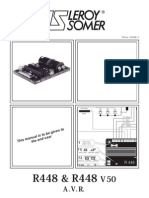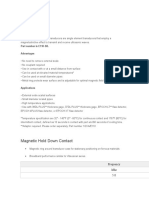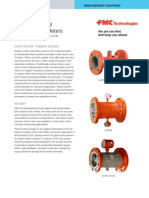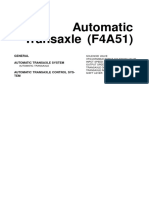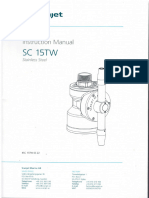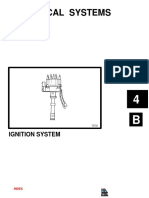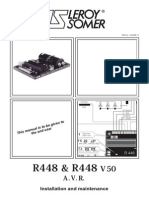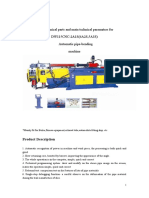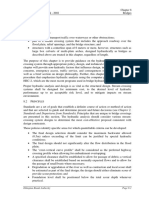Terz94 - Manual - GB Status 05 05
Terz94 - Manual - GB Status 05 05
Uploaded by
Matias Van Balen BlankenCopyright:
Available Formats
Terz94 - Manual - GB Status 05 05
Terz94 - Manual - GB Status 05 05
Uploaded by
Matias Van Balen BlankenOriginal Description:
Original Title
Copyright
Available Formats
Share this document
Did you find this document useful?
Is this content inappropriate?
Copyright:
Available Formats
Terz94 - Manual - GB Status 05 05
Terz94 - Manual - GB Status 05 05
Uploaded by
Matias Van Balen BlankenCopyright:
Available Formats
Electronic Turbine Meter
TERZ 94
Operating Instructions
RMG Meßtechnik GmbH Status: 05/05
Otto-Hahn-Strasse 5 · 35510 Butzbach (Germany) Serving the Gas Industry
P.O. Box 280 · 35502 Butzbach (Germany) – WORLDWIDE
Tel: +49 6033 897-0 · Fax: + 49 6033 897-130
Table of Contents
Introduction.............................................................................. 1
Functional Description............................................................ 2
Construction ............................................................................................. 2
Meter head ............................................................................................... 3
Block diagram .......................................................................................... 3
Safety Instructions .................................................................. 5
Installation................................................................................ 6
Operating conditions ................................................................................ 6
Pressure loss ........................................................................................... 7
Installation ................................................................................................ 7
Electrical connections............................................................................... 9
Installing the remote totalizing unit ......................................................... 13
Start-up ................................................................................... 14
Connecting the gas flow ......................................................................... 14
Initializing the totalizing unit.................................................................... 14
Operation................................................................................ 15
Display ................................................................................................... 15
Programming.......................................................................................... 17
Parameters and Modes of the TERZ 94 / 94-S ...................................... 21
Power Supply ......................................................................... 27
Maintenance ........................................................................... 28
Lubrication.............................................................................................. 28
Changing the battery .............................................................................. 29
Specifications ........................................................................ 30
Measuring range .................................................................................... 30
Measuring error ...................................................................................... 30
Temperature ranges............................................................................... 30
Inputs and outputs.................................................................................. 30
Materials used for the meter case .......................................................... 34
Examples of connection ......................................................................... 35
Annex...................................................................................... 38
Overview of parameters ......................................................................... 38
Standard parameters (factory setting) .................................................... 39
Fault and event display .......................................................................... 41
Matrix of the TERZ 94 / 94-S.................................................................. 42
TERZ 94 button assignments................................................................. 43
Converting the TERZ 94 into the TERZ 94-S ......................................... 44
Cable type abbreviations........................................................................ 45
EC type approval certificate ................................................................... 47
Operating Instructions for the TERZ 94 Electronic Turbine Meter
Introduction
Introduction
The TERZ 94 / 94-S turbine meter complements the RMG TRZ 03,
TRZ 03-L and TRZ 03 K turbine meters (see RMG Publication Nos. 3.161-
E and 3.171-E).
The TERZ 94 / 94-S directly measures the flow rate at measurement
conditions and integrates the measured values, so that, as a result, the
gas volume which flowed through the meter is registered by an electronic
totalizing unit. The gas flow drives a turbine wheel whose speed is
recorded through non-contact measurement by a sensor. Therefore, the
meter is characterized by long-term stability and low wear.
The TERZ 94 / 94-S is provided with HF and LF outputs which allow the
device to be used as a flow transducer for control applications and remote
transmission.
Features
− For secondary applications
− With electronic totalizing unit
− Flow display
− Display of maximum flow values
− Alarm output
− Detachable meter head (for use as a remote totalizer)
− Digital transmission of meter readings
The two variants TERZ 94 and TERZ 94-S differ in the following features:
TERZ 94
− Battery operation
− Electronic suppression of the slow-down effect of the turbine wheel after
flow stop by external shut-down of the totalizer
TERZ 94-S
− External power supply
− 4-20 mA current output for outputting the flow rate
Operating Instructions for the TERZ 94 Electronic Turbine Meter 1
Functional Description
Functional Description
Construction
11
10
2
8
4
7 6 5
Part Designation Material
1 Meter head
2 Set screw Steel
3 Sensor WF01 (1-channel) or WF02 (2-
channels)
4 Permanent magnet Oerstit 500
5 Lubricator (from DN 200)
6 Radial ball bearing Nirosta steel
7 Turbine wheel Delrin / aluminium
8 Flow straightener Hostaform
9 O-ring
10 Sensor sleeve with sensor Nirosta steel
11 O-ring 8x2.5 83FKM592
2 Operating Instructions for the TERZ 94 Electronic Turbine Meter
Functional Description
The TERZ 94 / 94-S volumeters form a series of uniform construction.
The meters consist of the following principal components:
- meter case
- measuring element (with turbine wheel and sensor) and
- electronic totalizing unit.
An aerodynamic flow straightener (8) fitted into the meter case constricts
the effective cross section of the pipe to form a ring-shaped cross-
sectional area and substantially eliminates turbulences. The velocity of the
flowing gas increases and the gas is directed to the turbine blades.
The turbine wheel (7) is dynamically balanced and mounted with dust-
proof ball bearings (6). A permanent magnet (4) located at the end plate of
the turbine shaft induces the sensor element (3) to give a voltage pulse
with each rotation of the turbine wheel. This pulse is further processed by
the electronic system of the meter head (1).
Meter head
Inside the meter head, the number of pulses is divided by the meter factor
(number of pulses per m3) and the result is used to calculate the volume at
measurement conditions. In the main totalizer, the sum of the volume at
measurement conditions which flowed through the meter is formed and
you can read the gas volume which flowed through the meter per time unit
on the flow rate display.
At the HF output, the unchanged signal frequency of the sensor element is
outputted, whereas, for the LF output, this HF frequency can be reduced
by two programmable scaling factors.
Block diagram
TERZ 94
In the display field of the TERZ 94 (not with the TERZ 94-S), a start-stop
totalizer or a resettable totalizer can be optionally displayed. Through the
free sensor input X5, either the volume metering of the start-stop totalizer
is interrupted or the resettable totalizer is reset (depending on the
programming of the TERZ 94).
TERZ 94-S
The TERZ 94-S volumeter has a current-loop connection (X2_0 with
current module TERZ94trm) which serves as power supply and 4 to 20 mA
current output at the same time. For this purpose, a power supply unit is
required which is to be connected to this output. The TERZ 94-S cannot
be battery-operated.
Operating Instructions for the TERZ 91 Electronic Turbine Meter 3
Functional Description
TERZ 94 1-channel
Channel 1
f Current output
i
1 1 12345678 m3
Start/Stop K n
Reset
1
n LF output
HF output
Alarm contact
Option:
EZD or RS485 interface
TERZ 94 2-channel
Channel 1
f Current output
i
With 2 channels: 1 1 12345678 m3
pulse
monitoring K n
Channel 2
10 / 10000
180 °
1
n LF output
HF output
Alarm contact
Option:
EZD or RS485 interface
4 Operating Instructions for the TERZ 94 Electronic Turbine Meter
Safety Instructions
Safety Instructions
The TERZ 94 / 94-S volumeter is used for measuring the volume at
measurement conditions of non-corrosive gases and fuel gases.
Measurement of corrosive gases is only permitted if the special designs
are used which have been developed for such purpose. These meters are
not suitable for measuring liquids, otherwise they will be destructed.
The TERZ 94 / 94-S complies with currently applicable standards and
regulations. However, failure to operate them properly may cause hazards.
Persons who install or operate the TERZ 94 / 94-S volumeter in areas
subject to explosion hazards, must be familiar with the currently applicable
explosion protection standards and regulations.
The electronic totalizing unit of the explosion-protected design has been
approved for use in areas subject to explosion hazards and its code is:
II 2 G EEx ib[ia] IIC T3, T4
The appropriate certificate of conformity can be found in the annex and its
reference number is:
TÜV 02 ATEX 1970
Please observe the following signs:
Danger of explosion
In the manual, this symbol warns you of an explosion hazard.
Please observe the instructions given next to this symbol. As to
the danger of explosion, please note the following in particular:
• Only the explosion-protected design of the TERZ 94 / 94-S
may be used in areas subject to explosion hazards.
• The battery must be changed in an area without explosion
hazards.
Damage to property
In the manual, this symbol warns you of possible damage to
property. The instructions given next to this symbol inform you
about what you can do to avoid damage to the TERZ 94
volumeter.
It is essential to observe the warning information in these operating
instructions and the generally applicable safety rules.
No warranty claims can be asserted if there is unauthorized interference
with the device!
Operating Instructions for the TERZ 94 Electronic Turbine Meter 5
Installation
Installation
Operating conditions
Permissible types of gases
The standard design of the TERZ 94 or TERZ 94-S can be used for all
non-corrosive gases, such as
Natural gas Air
Town gas Acetylene
Methane Helium
Ethane Carbon dioxide (dry)
Propane Nitrogen
Butane Hydrogen
Special designs (PTFE lining, special lubrication, special material, etc.)
can be used for corrosive and humid gases, such as
Ethylene Digester gas
Biogas Sulphur dioxide
Acid gas etc.
Permissible temperature ranges
For the standard design, the following fluid temperature and ambient
temperature ranges are permitted:
Fluid temperature range: -10°C to +50°C
Ambient temperature range: -20°C to +60°C resp. +40°C
6 Operating Instructions for the TERZ 94 Electronic Turbine Meter
Installation
Pressure loss
The pressure loss is calculated using the following formula:
2
QM
∆p = Z P ⋅ ρ ⋅
DN 4
where
∆p is the pressure loss [mbar]
ZP is the pressure loss coefficient
ρ is the density [kg/m3]
QM is the flow rate at measurement conditions [m3/h]
DN is the nominal diameter of the meter [mm]
The pressure loss coefficient ZP is constant for all volumeters of the types
TERZ 94 and TERZ 94-S. It is:
ZP = 5040
This is an approximate mean value. The exact value is calculated from the
pressure loss which is determined on testing the volumeter.
Example of calculation:
QM = 650 m3/h; DN 150; ρ = 1.3 kg/m3 [natural gas, 600 mbar]
2
QM 650 2
∆p = Z P ⋅ ρ ⋅ = 5040 ⋅ 1.3 ⋅ = 5.5 mbar
DN 4 150 4
Therefore, the pressure loss ∆p with a volumeter of the type TERZ 94 is
5.5 mbar in this case.
Installation
The gas flow must be free of shocks and pulsations as well as free of
foreign particles, dust and liquids. Any components affecting the gas flow
must absolutely be avoided directly upstream of the TERZ 94 volumeter.
To achieve the highest possible accuracy (measuring error <1%), an inlet
pipe of 2 DN in length with a perforated-plate straightener should be
installed upstream of the meter.
You can install the meters in any position (vertical or horizontal) up to and
including the nominal diameter of DN 200. From the nominal diameter of
DN 250, only the position stated in the purchase order is possible.
When you install the volumeter, please observe the direction of flow
indicated on the case!
Operating Instructions for the TERZ 94 Electronic Turbine Meter 7
Installation
The meter head (1) can be turned after the set screw (2) has been
loosened. Turn the meter head by max. 360°, otherwise the signal wires
can become twisted and break.
You can install the meter head also vertically. To do this, you must
proceed as follows:
• Unscrew the cover of the meter head.
• Disconnect the two wires from terminal X5 (remember the polarity!).
• Loosen the set screw (2). Now you can remove the case of the meter
head and an aluminium assembly part will appear.
• On the side of the case, there is a hole which is covered with a screw.
Mount the retainer part to this hole and close the hole in the rear panel
by means of the screw.
• Thread the signal wires through the retainer part, place the meter head
onto the turbine case, turn it into the desired position and retighten the
set screw (2).
• Connect the signal wires again to terminal X5 (make sure that the
polarity is correct!) and screw on the cover again.
8 Operating Instructions for the TERZ 94 Electronic Turbine Meter
Installation
Electrical connections
The LF and HF volume pulses and the current output in non-Ex devices
are led out of the meter head by a 7-pin connector (Binder). All other
connections have to be made at the terminals on the board.
Standard connection TERZ 94 (Ex and non-Ex devices) and
TERZ 94-S (Ex devices):
4 3
1-/4+ LF signal
5 2
2-/5+ not connected
6 1 3-/6+ HF signal
PE (Screening)
PE (Abschirmung)
Standard connection TERZ 94-S (non-Ex devices):
4 3
1-/4+ LF signal
5 2
2-/5+ Current output 4 to 20 mA
6 1 3-/6+ HF signal
PE (Screening)
PE (Abschirmung)
In areas subject to explosion hazards, the TERZ 94 must only
be connected to certified intrinsically safe circuits.
Make sure that the limiting values from the conformity
certificate (see appendix) for the devices, which have to be
connected, are not exceeded.
If one or more electric circuits are used, it is to ensure that with the cable
selection the permissible limiting values according to the EEC design
inspection certificate are not exceeded. Each ex signal circuit has to be
wired in its own cable, which is to be led through the appropriate cable
gland. A fixed installation of the intrinsically safe cables is mandatory. The
connecting cables have to be provided with core-end sleeves.
Operating Instructions for the TERZ 94 Electronic Turbine Meter 9
Installation
To reach the electrical connections on the board, you must first remove
the cover of the meter head.
Plug X3 Pin connector button
Service module on the case
Plug X2_0
for current module
TERZ94trm and supply
Reset
(soldering pads)
Terminal block X4
Pulse outputs
Terminal X5
Pulse inputs
Jumper
XTERZ90
Programming keys
Jumpers X_S1 and X_S2 for
configuration of pulse inputs
To convert from the meter head directly mounted on the meter case to the
remote totalizing unit and vice versa it is necessary to change the
positions of some jumpers (see inputs and outputs in the annex).
X_S1 (and X_S2*) X_TERZ90
Meter head mounted on meter case 3-5 and 4-6 all open
Remote totalizing unit 3-5 and 4-6 1-2 (and 3-4*)
* for 2-channel measurement only
TERZ 94:
Controlling the start-stop totalizer or resetting the resettable totalizer
(depending on the programming of the electronic totalizing unit) is
performed through input X5 terminals 1 and 2.
As soon as input X5 terminals 1 / 2 has been short-circuited through an
external contact, interruption or resetting is performed.
⇒ For this purpose, set jumpers at the positions identified with XS 2 to
the “reed contact” function.
10 Operating Instructions for the TERZ 94 Electronic Turbine Meter
Installation
TERZ 94-S:
In the case of the TERZ 94-S, terminal X22 (on current module
TERZ94trm) is used as current-loop connection to supply the device and
as output current (4-20 mA).
The output signals can be picked up at the following terminals:
HF signals: Output X4, terminals X4,4 (+) / X4,3(-)
LF signals: Output X4, terminals X4,2 (+) / X4,1(-)
Now connect the cables and then put the cover again on the lower part of
the housing.
To connect the cables to the spring terminals, you need a screwdriver with
a blade width of a maximum of 2.5 mm. Introduce the blade into the
intended slot and press down the screwdriver to open the spring terminal.
Earthing
To prevent measuring errors caused by electromagnetic interference, you
must not fail to earth the case of the meter head via the earthing screw
on the left side of the case.
Minimum cable cross section:
up to a length of 10 m: 6 mm2
from a length of 10 m: 10 mm2
Earthing screw
Cables
Use 2-core or multicore shielded cables which are twisted together in
pairs (type LIYCY) for the signal lines (LF output, HF output, current-loop
connection, control input). The shielding must always be connected to
earth on both sides. In the case of the TERZ 94, you must proceed as
described in the chapter “Cable glands”.
Operating Instructions for the TERZ 94 Electronic Turbine Meter 11
Installation
We recommend that cable cross sections between 0.25 mm2 and 0.5 mm2
are used. Due to the cable gland, the outside diameter must be between
4.5 mm and 6.5 mm.
When the device is used in areas subject to explosion hazards, the
maximum cable length is limited by the limit values for intrinsically safe
circuits and depends on the inductance and capacitance of the cable!
Cable glands
Clamp the shielding on both sides, as shown in the picture below, into the
cable glands located on the outside of the case:
• Unscrew the cap nut.
• Pull out the plastic clamping piece.
• Push the cable end through the cap nut and the clamping piece and
bend the shielding backwards.
• Put the clamping piece back into the connecting piece.
• Screw on the cap nut again.
Cap nut
Clamping piece
O-ring
Connecting piece
12 Operating Instructions for the TERZ 94 Electronic Turbine Meter
Installation
Installing the remote totalizing unit
24 VDC
- 0085
Current output 4-20mA yes no
IP65
X3 X1 X16_0
Taster
Sensor
Servicemodul TERZ94p
TERZ94trm -
CX6
X2_0
-
Impulsausgänge Zählwerk Zählwerk
C21
X7
X4 Q1 Impulseingang
- +
RESET
V12 + Index Input Index Input
V13
C1 -
+
C22
+
V14
- +
X5
TP-GND Sensor
Sensor
Datenschnittstelle XLP1 EZSENS01
-
X6_0
Boot
EZD/RS-485
4
X151
PT1000
-
Sensorverstärker 3+4
Zählwerk Zählwerk
X9
Datenschnittstelle
Wiegand 3+5 / 4+6
L1
Reed 1+3 / 2+4
1 - +
CX1
CX3
X15
Index Input Index Input
CX2
4 2
X_S1
1 3 5
X_S2
1 3 5
TEMP_LM7X
X10-0 5 +
3 1
X_TERZ90
+
X152
2 6
2
S3 S1 S2 S4
Sensor
P
If your TERZ 94 is designed for remote totalizing, you can install the
totalizing unit at a distance of up to 50 m from the meter case. Usually, the
cable has already been connected to the totalizing unit when the TERZ 94
is delivered. Should this not be the case, you will have to connect the
connecting cable to Input-terminal X5, clamp S1+ and clamp S1- of the
board. For 2-channel meters connect the second sensor to the clamps
S2+ and S2-. Use only shielded cables of the type:
LIYCY - 2 x 0.75 blue (standard)
LIYCY - 2 x 2 x 0.75 blue (2-channel version)
Maximum cable length: 50 m
Furthermore, you must check the plug-in jumpers XS1, XS2 and XTERZ90
on the display board.
Settings at XS1 and XS2: jumpers 3-4
Operating Instructions for the TERZ 94 Electronic Turbine Meter 13
Inbetriebnahme
Start-up
Connecting the gas flow
Do not fill any downstream pipelines or station sections through
the TERZ 94. This may speed up the turbine wheel and lead to
excessively high flow rates with resultant damage.
Short-time overload operation of 20% above the maximum flow rate Qmax
is permissible. No damage will occur in the case of a return flow without
shocks.
Before starting up the device, make sure that all lines have been correctly
installed and connected in the terminal compartment.
The case must be completely closed.
Initializing the totalizing unit
When you start up the device for the first time, set the totalizing unit in the
desired condition.
Check the programming of the pulse width, the LF pulse scaler, etc.
TERZ94-S:
Check the programming of the current output mode.
NOTE:
All parameters can only be changed after the cover of the meter has been
removed.
14 Operating Instructions for the TERZ 94 Electronic Turbine Meter
Operation
Operation
Display
In normal operating mode, the main totalizer is displayed.
When you press the control button on the right side of the case, all values
will be shown.
After the preset display wake-up time has elapsed, the main totalizer will
appear again.
If the display of the TERZ 94 does not show anything, the device is in
energy-saving mode. In this mode, the display is switched off. However,
incoming pulses are processed and the outputs are set. As soon as you
press the control button, the display values will appear again.
Display
switched off:
0 0 0 0 5 8 3 1 m3 Main totalizer Vm
1 0. 0 0 0 m3/h Flow rate
0 0 0 0 0 0 0 0 m³ Start / stop totalizer
0 0 0 0 0 0 0 0 m³ Resettable totalizer
5 0. 0 0 P/m³ Meter factor
Operating Instructions for the TERZ 94 Electronic Turbine Meter 15
Operation
1 -- Pulse scaler
000 0 0 0 0 1 MOD Configuration
0000008000 S.No. Serial number
Extra values for the TERZ 94-S
80.38 Hz Frequency (sensor)
0 0 0 0 5 8 3 1 m3 Main totalizer
An overview of parameters and the complete matrix are shown in the
annex.
16 Operating Instructions for the TERZ 94 Electronic Turbine Meter
Operation
NOTE:
The button located externally on the case reacts when it is released and
not when it is pressed. The duration of pressing the button is evaluated
and results in different reactions of the device.
Pressing the button for a short time causes the display to show the next
display value, while pressing the button for a longer time (more than 2
seconds) will activate all segments of the display (segment test) and then
the display will switch over to showing the Vm totalizer.
The following text describes procedures where the button is normally
pressed for a short time.
Programming
For programming the TERZ 94 / 94-S, there are four buttons on the rear
side of the board. Alternatively, you can program the device with the
programming module (available as an accessory). The programming
module is to be connected to the pin connector indicated in the picture
below.
→
|
-
+
P
Programming
module
Operating Instructions for the TERZ 94 Electronic Turbine Meter 17
Operation
Programming with the programming module is to be performed in the
same way as with the buttons..The external and internal buttons
correspond to each other in the following way:
Int. button Ext. button Meaning
P P Display mode:
Switch over to programming mode
(Press the button longer than 2 seconds)
Programming mode:
Set the decimal point.
+ ∧ Display mode:
Switch over to the next higher level.
Programming mode:
- Increase the decimal by 1.
- Scroll in the list.
(Value identified with “L“)
- ∨ Display mode:
Switch over to the next lower level.
Programming mode:
- Decrease the decimal by 1.
- Scroll in the list.
(Value identified with “L“)
→
|
→
|
Display mode:
Short-time view of the coordinate (e.g. A01)
Programming mode:
Go to the right by one decimal place (if the last
decimal has been reached: Quit programming
mode).
18 Operating Instructions for the TERZ 94 Electronic Turbine Meter
Operation
Principle of programming
For programming, you must always proceed as follows:
• First change over to the display value to be modified.
− To do this, press either the control button (only forwards)
− or the internal buttons “+” and “-” or the external buttons “∧” and “∨”
(forwards and backwards).
• Change to programming mode by pressing “P” for at least 2 seconds.
On the left side of the display, a flashing character or cursor will appear.
If necessary press the “ |→” key so many times until a flashing character
appears.
Flashing character
0 1 2 3.2 3 P/m3
• You can now modify the flashing decimal by pressing either “+” or “∧”
(+1) or “-” or “∨” (-1).
Example: If you press the “∧“ button three times, the first decimal will be
increased from 0 to 3. If an “L” appears on the far left side of the
display, this value is a list. With a list, you can only scroll in the specified
values.
• After you have completed your programming of the first decimal, press
“|→ ” once and the next character will start to flash.
Now proceed with your programming until you have reached the last
decimal place.
• Then you must press “|→” once again to have the set value accepted
and quit programming mode.
• Press the “P“ button to set the decimal point behind the flashing digit.
With totalizers, modes and integers, no decimal point is permitted.
• Press the control button if you have made an error or if you want to
discontinue inputting data.
Operating Instructions for the TERZ 94 Electronic Turbine Meter 19
Operation
Display values
Measured values, such as flow rate, frequency, etc. are display values and
cannot be directly modified. However, there are many parameters which
influence the formation of these measured values. These parameters are
described in the following section.
Examples of display values:
Flow rate
Version number
Year of construction
Serial number
Value of the current output in mA
etc.
20 Operating Instructions for the TERZ 94 Electronic Turbine Meter
Operation
Parameters and Modes of the TERZ 94 / 94-S
In the following text, the individual parameters are described in detail.
1. Meter factor (pulse value) TERZ 94 / 94-S
With the meter factor (pulse value), the relevant flow rate at measurement
conditions is calculated from the signal frequency of the sensor element in
the electronic totalizing unit:
f m3
QM = ⋅ 3600
K h
f: Signal frequency (Hz)
K: Meter factor (pulses/m3)
QM: Flow rate at measurement conditions (m3/h)
The meter factor has been calibrated in the factory in such a way that
working cubic metres are directly displayed. Its value can be read from a
label located on the left side of the case.
Any modification of this adjustment is within the sphere of
responsibility of the operating company.
NOTE!
The new value is immediately used for all calculations
performed after each modification of the meter factor.
The uninfluenced signal frequency of the sensor element is available at
the HF output.
The frequency range can be determined from the meter factor K and the
minimum and maximum flow rates at measurement conditions of the
meter in accordance with the following formulae:
Q M min Q M max
fmin = ⋅K fmax = ⋅K
3600 3600
QMmin: Minimum flow rate at measurement conditions
QMmax: Maximum flow rate at measurement conditions
K: Meter factor (pulse value)
Example:
QMmin = 16 m3/h QMmax = 250 m3/h K = 2362 pulses/m3
16 250
fmin = ⋅ 2362 Hz = 10.5 Hz fmax = ⋅ 2326 Hz = 164 Hz
3600 3600
Operating Instructions for the TERZ 94 Electronic Turbine Meter 21
Operation
2. LF pulse scaler TERZ 94 / 94-S
The frequency of the LF pulses is set by a pulse scaler (A07). There are
the following setting options: 0.01; 0.1; 1; 10; 100.
Other values can not be programmed, it is only possible to scroll in the list
of these values (‘t’ key vesp. ‘_’ key).
This pulse scaler has only effect on the frequency of the LF pulses not on
the display. The number of displayed digits after decimal point or a
multiplier are programmed as an operating mode (A08)
Recommended values (= values set in the factory)
DN Pulse LF decade Pulse rate Maximum
scaler scaler output
frequency
[mm] [pulses/m3] [pulses/m3] [Hz] 1)
25 10 1 10 0.1
40 10 10 1 0.1
50 10 10 1 0.1
80 10 10 1 0.1
1002) 10 10 1 0.1
150 1 1 1 0.3
200 1 1 1 0.6
250 1 1 1 0.7
300 1 1 1 1.1
400 1 10 0.1 0.2
500 1 10 0.1 0.3
600 1 10 0.1 0.4
1)
Rounded values
2)
In the case of the design with Qmax=650 m3/h, the LF decade scaler is
set at 1.
22 Operating Instructions for the TERZ 94 Electronic Turbine Meter
Operation
3. Configuration
The basic configuration of the TERZ-94 is implemented via an 8-character
display value (A08). This “TERZ mode” defines the operating mode of the
device.
Some parameters require a specific hardware or hardware configuration.
NOTE!
Hardware and software configurations must coincide.
Any modifications of these parameters can cause malfunctions.
Let’s start on the left side of the display: (operating alignment italic)
− Internal parameters
For testing and diagnostics (no influence on the metering result).
0: Menu for standard operation.
1: Menu for service
9: All parameters visible.
− Main totalizer mode
This parameter defines the unit for the gas volume
0: m3 (cubic meter).
1: cf (cubic foot).
− LF pulse width
The LF pulse width can be set at 125 ms or 250 ms.
0: 125 ms
1: 250 ms
− Cut-off time of the display
A few minutes after you have operated the device for the last time, the
display will switch off to expand the service life of the battery of the
TERZ-94. There are the following times for selection:
0: 1 minute
1: 5 minutes
2: 10 minutes
3: 15 minutes
4: 1 hour (for test purpose only!)
− Interface protocol
0: OFF
1: EZD protocol 0x00 / Standard Vo protocol (NAMUR)
2: EZD protocol 0x7f / Vo protocol for external devices (NAMUR)
3: Test protocol
Operating Instructions for the TERZ 94 Electronic Turbine Meter 23
Operation
− Pulse scale
In this operating mode the display is set. To get the real totalizer
readings the displayed value must be multiplied with the multiplier.
0: 2 digits after decimal points, multiplier: 1
1: 1 digit after decimal points, multiplier: 1
2: no digits after decimal points, multiplier: 1
3: no digits after decimal points, multiplier: 10
4: no digits after decimal points, multiplier: 100
− Current output
0: OFF
1: Current output is active
2: Current output is active and faults are signalled (3,5 mA)
3: Current output is active and faults are signalled (21,8 mA)
− TERZ operating modes
There are the following operating modes at the moment:
0: ENCO-F
1: ENCO-M
2: TERZ 94 1 channel
3: TERZ 94 1 channel with start / stop totalizer
4: TERZ 94 1 channel with reset totalizer
5: TRZ03-TE/TEL 2 channels with pulse monitoring (SW), Vm Stop
6: TRZ03-TE/TEL 2 channels with pulse monitoring (SW), Vm Run
7: TRZ03-TE/TEL 2 channels with pulse monitoring (HW), Vm Stop
8: TRZ03-TE/TEL 2 channels with pulse monitoring (HW), Vm Run
9: TRZ03-TE/TEL 2 channels without pulse monitoring
SW means “pulse monitoring by software”, HW by hardware; Vm Stop
means totalizer is stopped in case of a fault whereas the counting
continnes in the mode Vm Run.
Example:
00110112 MOD
2: TERZ – 1 channel
1: Current output is active, faults are not signalled.
1: Display of 1 digit after decimal point
0: Interface protocol off
1: Display cut-off time: 5 minutes
1: LF pulse width: 250 ms
0: Display in m3
0: Operating mode: No diagnostics mode is activated
24 Operating Instructions for the TERZ 94 Electronic Turbine Meter
Operation
4. Pulse comparator
The 2-channel version of the TERZ-94 (TRZ03 TE / TEL) provides for
pulse monitoring.
Pulse monitoring requires two input pulses which are out of phase.
If a pulse occurs at the same time on channel 1 and channel 2, a fault
counter is increased. If there is a missing pulse on one of the two
channels, a fault counter is increased, too.
If this fault counter reaches the value X(A10) before Y(A11) undisturbed
pulses have entered one of the two channels, a fault will be outputted.
This fault will not be erased until Y undisturbed pulses have been counted.
5. Flow rate at 4 mA
With this parameter, you set the flow rate (in m3/h) which corresponds to
an outputted current of 4 mA. Generally, the minimum flow rate Qmin of the
meter is set here. (This setting is made in the factory.)
6. Flow rate at 20 mA
With this parameter, you set the flow rate (in m3/h) which corresponds to
an outputted current of 20 mA. Generally, the maximum flow rate Qmax of
the meter is set here. (This setting is made in the factory.) Then the
current which will be outputted for flow rates within the programmed limits
will be between 4 and 20 mA and results from linear conversion.
7. Current default value (calibration current)
With this parameter, you set the value of the calibration current. A
constant calibration current is outputted if the current output mode
parameter is set to default. The value of the calibration current must be
within the following limits:
Minimum value: 4 mA
Maximum value: 20 mA
8. Current output mode
Here you define the measured or default value which is to be outputted.
0: Default value (see above)
1: Flow rate Qm
All other values are not permitted!
Operating Instructions for the TERZ 94 Electronic Turbine Meter 25
Operation
9. Current damping
Here you define how the current output is to be damped.
Permissible values for D are 0 to 0.9 !
Output current = (1-D) x value + D x old value
10. Correction factors for current offset and current rise
The current output is adjusted in the factory through two correction factors
(offset and rise).
In the event that a recalibration should really be necessary, there is a PC-
based program available which will define the new offset and rise values
for you.
26 Operating Instructions for the TERZ 94 Electronic Turbine Meter
Operation
Power Supply
Depending on the type of the device, there are different options of power
supply.
1. The basic TERZ 94 model is supplied by an internal lithium battery
which enables to operate the device continuously for a period of six
years. This, however, is conditional on the device being read once a
week or “woken up” by pressing the external button.
2. If an interface module is used for transmitting data, such as the ENCO
with external supply, the service life of the battery is more than 10
years.
3. The TERZ 94-S (current transmitter) is completely supplied through a
current loop. If pulse processing is to be maintained even in the case of
a power failure of the current loop, a standby battery (available as an
option) should be installed which will bridge the power supply during a
period of up to 6 months.
Operating Instructions for the TERZ 94 Electronic Turbine Meter 27
Maintenance
Maintenance
Lubrication
The TERZ 94 is fitted with permanently lubricated bearings up to and
including the nominal diameter of DN 150. From the nominal diameter of
DN 200, the meter is fitted with a lubricator. The type of lubricator and the
lubrication instructions depend on the nominal diameter and the pressure
rating:
Nominal dia. Pressure rating Lubricator Lubrication
instructions
DN 200 PN 10 to 16, Oil gun Every 3 months
ANSI 150 (supplied) 2 strokes
DN 200 PN 25 to 100
ANSI 300 to 600 Small oil pump Every 3 months
(pushbutton- 6 strokes
DN 250 PN 10 to 16 operated)
ANSI 150
DN 250 PN 25 to 100 Large oil pump Every 3 months
ANSI 300 to 600 (lever-operated) 2 strokes
from DN 300 all pressure
classes
Please observe also the instruction plate on the case.
In the case of unfavourable operating conditions, such as the formation of
water or hydrocarbon condensate or the use of dust-laden gas, we would
recommend performing lubrication at shorter intervals, even daily under
extreme conditions (permanent formation of condensate).
Recommendations for lubricating oils:
Aero Shell Fluid 12 or another oil with 2 to 4°E at 25°C as per MIL-L-6085
A specification.
28 Operating Instructions for the TERZ 94 Electronic Turbine Meter
Maintenance
Changing the battery
Use only lithium batteries of the type SL 770/P Size C, 3.6 V produced by
Sonnenschein or type LS 33600 produced by Saft.
These batteries have a service life of a minimum of 6 years and can be
ordered ready for installation from RMG under the following order number:
For Non-Ex (not explosion-protected) devices: 86.90.613.00
For Ex (explosion-protected) devices: 86.90.614.00
• If you use other batteries than the replacement batteries from
RMG, you run the risk of the TERZ 94 not being approved for
areas subject to explosion hazards any more.
• In areas subject to explosion hazards, you must never insert
or remove the battery. Remove the display board from the
case and change the battery in an area without explosion
hazards.
To change the battery, you must proceed as follows:
• Remove the cover of the meter head – on the rear side, there is the
battery fixed with cable ties.
• If the meter is located in an area subject to explosion hazards,
disconnect the sensor wires from terminal X5 (see chapter “Electrical
connections” – Remember the terminals and colours!) and take the
display board to an area without explosion hazards.
• Remove the connecting wires of the battery from the contacts on the
bottom of the terminal board.
• Screw off the four screws with witch the battery board is fixed.
• Remove the cable ties with which the battery is fixed and take out the
battery.
• Insert the new battery and fix it with cable ties.
• Plug the connecting wires of the battery on the contacts of the terminal
board. Make sure that the polarity is correct.
• Reinsert the battery-board into the case and screw it on. In case you
have previously disconnected the wires of the sensor and the control
button, you must connect them again (make sure that the polarity of the
sensor wires is correct!).
• Close the case.
Operating Instructions for the TERZ 94 Electronic Turbine Meter 29
Specifications
Specifications
Measuring range
Under atmospheric pressure: 1:16
If the pressure increases, the measuring range of the meter extends.
Measuring ranges of up to 1:50 can be reached.
Measuring error
For Qmin to 0.2 · Qmax: ≤ ±2%
For 0.2 · Qmax to Qmax : ≤ ±1%
(DN 25: ≤ ±2% for Qmin to Qmax)
Reproducibility: ≤ ±0.5%
Temperature ranges
Fluid temperature range: -10°C to +50°C
Ambient temperature range:
TERZ 94 II2 G EEx ib IIC T4 -20°C to +40°C
II2 G EEx ib IIC T3 -20°C to +60°C
TERZ 94-S II2 G EEx ib IIC T4 -20°C to +60°C
In the case of special designs, even higher or lower fluid temperatures are
possible in non-Ex versions.
Inputs and outputs
Sensor input S1 (Measuring input)
(For Ex connected loads, see approval certificate)
Terminals: X5,1 (+)
X5,2 (-)
Sensor type:
Wiegand sensor, direct Line length < 50 cm
Jumpers X_S1 / 3-5 and 4-6
Wiegand sensor, remote totalizer Line length < 30 m
Jumpers: X_S1 / 3-5 and 4-6
Jumpers: X_TERZ90 / 1-2
Reed contact Jumpers X_S1 / 1-3 and 2-4
30 Operating Instructions for the TERZ 94 Electronic Turbine Meter
Specifications
Sensor input S2 (Comparative input or
start/stop/reset)
(For Ex connected loads, see approval certificate)
Terminals: X5,3 (+)
X5,4 (-)
Sensor type:
Wiegand sensor, direct Line length < 50 cm
Jumpers X_S2 / 3-5 and 4-6
Wiegand sensor, remote totalizer Line length < 50 m
Jumpers: X_S2 / 3-5 and 4-6
Jumpers: X_TERZ90 / 3-4
Reed contact Jumpers X_S2 / 1-3 and 2-4
HF output
In the case of the explosion-protected (Ex) design, the device can only be
connected to a certified intrinsically safe circuit.
Terminals: X4,4 (+)
X4,3 (-)
Output: Open-drain transistor
Tpulse 1 ms ± 10%
Fmax: 300 Hz
Ex Non-Ex
Umin: 4.0 V 4.0 V
Umax: 28 V 30 V
Imax: 60 mA* (total current) 400 mA
External inductance 1H
External capacitance 25 µF
* maximum total current of the 3 pulse outputs (LF + HF + Alarm)
Operating Instructions for the TERZ 94 Electronic Turbine Meter 31
Specifications
LF output
In the case of the explosion-protected (Ex) design, the device can only be
connected to a certified intrinsically safe circuit. (For Ex connected loads,
see approval certificate.)
Terminals: X4,2 (+)
X4,1 (-)
Output: Open-drain transistor
Tpulse 125 ms ± 10% (Fmax: 4 Hz)
250 ms ± 10% (Fmax: 2 Hz)
Ex Non-Ex
Umin: 4.0 V 4.0 V
Umax: 28 V 30 V
Imax: 60 mA* (total current) 400 mA
External inductance 1H
External capacitance 25 µF
* maximum total current of the 3 pulse outputs (LF + HF + Alarm)
Alarm output
In the case of the explosion-protected (Ex) design, the device can only be
connected to a certified intrinsically safe circuit. (For Ex connected loads,
see approval certificate.)
Terminals: X4,6 (+)
X4,5 (-)
Output: Open-drain transistor
Ex Non-Ex
Umin: 4.0 V 4.0 V
Umax: 28 V 30 V
Imax: 60 mA* (total current) 400 mA
External inductance 1H
External capacitance 25 µF
* maximum total current of the 3 pulse outputs (LF + HF + Alarm)
32 Operating Instructions for the TERZ 94 Electronic Turbine Meter
Specifications
Vo or RS-485 data interface
In the case of the explosion-protected (Ex) design, the device can only be
connected to a certified intrinsically safe circuit. (For Ex connected loads,
see approval certificate.)
Vo data interface: Internal Connector (Binder)
Terminals: X15,4 (+) 4
X15,3 (-) 1
X15,1 and X15,2 open
Umin: 7.0 V
Ui: 13.5 V
Ii: 15 mA
Pi: 210 mW
External capacitance: 2,5 µF
External inductance: 1H
Ex separating unit: KFD2-ST2-Ex1.LB (Pepperl+Fuchs)
RS-485 data interface:
Terminals: X15,4 (+ supply)
X15,3 (- supply)
X15,2 (line A)
X15,1 (line B)
Umin: 7.0 V
Ui: 10.5 V
Ii: 428 mA
Pi: 900 mW
Internal capacitance: 1,32 µF
Internal inductance: 600 µH
External capacitance: 23,7 µF
External inductance: 1H
Ex separating unit: 17-21S1-S111 / EExi (Bartec)
NOTE: If the EZD protocol or the RS485 bus is used, the device is
supplied via the data interface.
Operating Instructions for the TERZ 94 Electronic Turbine Meter 33
Specifications
Temperature input (hardware and software options)
For Ex connected loads, see approval certificate.
Terminals: X9,2 (+)
X9,1 (-)
Sensor type: PT 1000
Measuring range: -20°C to 60°C
Resolution: ± 0.2°C
Current-loop connection (TERZ 94-S only!)
Terminals: X22.1 (+)
X22,2 (-)
Uext (min): 12 V
Uext (max): 28 V
Imin: 3.5 mA
Imax: 23 mA
External load (max.): RLmax = (Uext - 10 V) / Imax (in Ω)
e.g. Uext = 16 V
⇒ RLmax = (16 V - 10 V) / 23 mA =
260 Ω
Current output with
- minimum flow rate: 4 mA
- maximum flow rate: 20 mA
- Warning: 3.5 mA
- Alarm: 23 mA
Accuracy, current output: Better than 1% of the final value
Data for the use in hazardous areas:
Ui = 28 V
Ii = 110 mA
Pi = 770 mW
Ci = 2,2 nF
Li = 110 µF
Materials used for the meter case
Spheroidal cast iron or steel, depending on the pressure class and the
nominal diameter. Aluminium is used for the threaded-end design.
34 Operating Instructions for the TERZ 94 Electronic Turbine Meter
Specifications
Examples of connection
Battery-operated device
Hazardous area Safe area
24 V/DC
PE
X4
1 2 3 4 5 6
PA
isolating amplifier
KFD2-SOT-Ex1 (24 V/DC)
alarm output PE
LIYCY 2x0.75 mm2 blue 1 12
11
3
7
8
Alarm
isolating amplifiers*
KFD2-SOT-Ex2 (24 V/DC)
PE
12
4 11
6
9
connector,
HF
pulse outputs 10
Binder series 693 LIYCY 2x2x0.75 mm2 blue PE
12
1 11
3
7
8
LF
connector pin assignment:
* If 2-channel isolating amplifiers
3
are used, the two inputs must
4
be separated!
5 2
HF + (6)
HF - (3)
6 1 LF + (4)
LF - (1)
PE (screen)
Operating Instructions for the TERZ 94 Electronic Turbine Meter 35
Specifications
Main-powered device (Ex design)
(Connection only via the current module with built in backup battery)
Hazardous area Safe area 24 V/DC
PE
X4
1 2 3 4 5 6
PA
isolating amplifier
KFD2-SOT-Ex1 (24 V/DC)
alarm output PE
LIYCY 2x0.75 mm2 blue 1 12
11
3
7
8
Alarm
isolating amplifiers*
KFD2-SOT-Ex2 (24 V/DC)
PE
12
4 11
6
9
connector, pulse outputs 10
HF
Binder series 693 LIYCY 2x2x0.75 mm2 blue PE
12
1 11
3
7
8
LF
supply unit
KFD2-STC3-Ex1 (24 V/DC)
current output
LIYCY 2x0.75 mm2 blue
connector pin assignment:
* If 2-channel isolating amplifiers
4 3 are used, the two inputs must
be separated!
5 2
HF + (6)
HF - (3)
6 1 LF + (4)
LF - (1)
PE (screen)
36 Operating Instructions for the TERZ 94 Electronic Turbine Meter
Specifications
Main-powered device (Non-Ex design)
(Connection only via the current module with built in backup battery)
24 V/DC
Safe area PE
X4
1 2 3 4 5 6
PA
alarm output
LIYCY 2x0.75 mm2 blue
HF-, NF- und Alarmausgang:
Alarm
Umax: 30 V
Maximale Summe der Ströme in allen
3 Ausgängen: 400 mA
HF
connector,
Binder series 693 outputs LF
LIYCY 3x2x0.75 mm2 blue
supply unit
KFD2-STC3-Ex1* (24 V/DC)
connector pin assignment:
* Alternatively also the supply unit
4-20 mA + (5) type KFD2-CR-1.300 is applicable.
4 3 4-20 mA - (2) If the current output is not used,
5
HF + (6) a direct connection to 24 V/DC
2
HF - (3) is possible.
6 1 LF + (4)
LF - (1)
PE (screen)
Operating Instructions for the TERZ 94 Electronic Turbine Meter 37
Annex
Annex
Overview of Parameters for the TERZ 94/94-S
Parameter Setting Example
(display)
A01 Main totalizer (Vm) 0 to 99999999 12345678 m³
A02 Flow rate (Qm) 12.3 m³/h
A03 Disturbing quantity totalizer 0 to 99999999 123 m³
A04 Start-stop totalizer 0 to 99999999 12345678 m³
A05 Resettable totalizer 0 to 99999999 12345678 m³
A06 Meter factor in all: six digits 12.3456 P/m³
A07 Pulse scaler 0.01; 0.1;1;10;100 L 1 --
A08 Configuration TERZ operating mode 00011021 MOD
A09 Error Rolling display 0 ERR
B01 Serial number 0 to 99999999 12345678 MOD
C01 Current output TERZ 94-S 12.345 mA
C02 Flow rate at 4 mA 0 to 999999.99 20.00 --
C03 Flow rate at 20 mA 0 to 999999.99 650.00 --
C04 Calibration current 4.000 to 20.000 4.000 mA
C05 Current output mode 0 – Default value 3 MOD
1 – Flow rate Qm
C06 Correction factor - Offset 0 to 99999999 1234.5678 --
C07 Correction factor - Rise 0 to 99999999 1234.5678 --
C08 Damping display / current 0 to 0.9 0.4 --
output
Z06 Frequency display 651 Hz
38 Operating Instructions for the TERZ 94 Electronic Turbine Meter
Internal parameters: Menu for standard operation Pulse width LF output: 250 ms Units: Cubic meter (m3)
Cut-off time of the display: 5 minutes Interface protocol: Off
Parameter Settings
Nominal diameter DN25 DN40 DN50 DN80 DN80 DN100 DN150 DN150
3
Qm max (m ) 25 65 100 160 250 400 650 1000
A06 Meter factor 13000 7750 7700 2380 2380 1060 580 330
3
A07 Pulse scaler (pulses/m ) 10 1 1 1 1 1 1 1
A08 Configuration
1 channel 00110102 00110102 00110102 00110102 00110102 00110102 00110202 00110202
2 channels, X:Y deactivated 00110109 00110109 00110109 00110109 00110109 00110109 00110209 00110209
1 channel with 4 - 20 mA 00110112 00110112 00110112 00110112 00110112 00110112 00110212 00110212
without faults
Operating Instructions for the TERZ 94 Electronic Turbine Meter
2 channels, X:Y deactivated 00110119 00110119 00110119 00110119 00110119 00110119 00110219 00110219
with 4 - 20 mA without faults
C01 Output current
C02 Flow rate at 4 mA 0 0 0 0 0 0 0 0
C03 Flow rate at 20 mA 25 65 100 160 250 400 650 1000
C04 Calibration current variable, programmable from 4 - 20 mA
C05 Current output mode
0=default value / 1=flow rate 1 1 1 1 1 1 1 1
Q
C06 Correction factor (offset) variable, programmable from 4 - 20 mA
39
Annex
Standard Parameters (values set in the factory) up to DN 150
C07 Correction factor (rise) variable, programmable from 4 - 20 mA
C08 Damping 0.7 0.7 0.7 0.7 0.7 0.7 0.7 0.7
Internal parameters: Menu for standard operation Pulse width LF 250 ms Units: Cubic meter (m3)
40
Cut-off time of the display: 5 minutes Interface protocol:: Off
Annex
Parameter Settings
Nominal diameter DN200 DN200 DN250 DN250 DN300 DN400 DN500 DN600
3
Qm max (m ) 1600 2500 2500 4000 4000 6500 10000 16000
A06 Meter factor 135 80 75 44 48 24 12 6
3
A07 Pulse scaler (pulses/m ) 1 1 1 1 1 1 0.1 0.1
A08 Configuration
1 channel 00110202 00110202 00110202 00110202 00110202 00110202 00110302 00110302
2 channels, X:Y deactivated 00110209 00110209 00110209 00110209 00110209 00110209 00110309 00110309
1 channel with 4 - 20 mA 00110212 00110212 00110212 00110212 00110212 00110212 00110312 00110312
without faults
2 channels, X:Y deactivated 00110219 00110219 00110219 00110219 00110219 00110219 00110319 00110319
with 4 - 20 mA without faults
C01 Output current
C02 Flow rate at 4 mA 0 0 0 0 0 0 0 0
C03 Flow rate at 20 mA 1600 2500 2500 4000 4000 6500 10000 16000
C04 Calibration current variable, programmable from 4 - 20 mA
C05 Current output mode
0=default value / 1=flow rate 1 1 1 1 1 1 1 1
Q
C06 Correction factor (offset) variable, programmable from 4 - 20 mA
Standard Parameters (values set in the factory) from DN 200
Operating Instructions for the TERZ 94 Electronic Turbine Meter
C07 Correction factor (rise) variable, programmable from 4 - 20 mA
C08 Damping 0.7 0.7 0.7 0.7 0.7 0.7 0.7 0.7
Annex
Fault and Event Display (coordinate A09)
In the TERZ 94/94-S there are 16 error messages.
The error numbers are indicated in a roll mode, if more than one error is
active, the display changes each second to the next active error (1... 5...
1... 5...).
Number "0" means faultless operation.
Fault Fault description Remedy
No.
0 No fault -----
1 wrong EEPROM version, invalid TERZ 94 PCB board must be
constant exchanged
2 Pulse fault: (sensor loss / 10:10000 Check the electrical connection
(X:Y)) of the sensor. Possibly the
sensor must be exchanged.
3 EEProm Hardware fault TERZ 94 PCB board must be
exchanged
4 -----
5 Current output min/max fault: Entered range values (C02 and
(wrong range values) C03) are wrong or the value of
the counter factor is wrong.
Check the values and chenge
them if necessary.
6 -----
7 -----
8 Pulse output LF: (more than 500 NF Value of the LF output pulse
pulses accumulated in the memory) factor (A07) is too high and must
be adapted.
9 -----
10 Configuration ist wrong Selected mode of operation is
wrong. Change the operation
mode in coordinate A8.8 to 2.
11 -----
12 -----
13 -----
14 -----
15 -----
16 -----
Operating Instructions for the TERZ 94 Electronic Turbine Meter 41
Annex
Matrix of the TERZ 94 / 94-S
Terz94 Terz94 Terz94-S Terz94-S
Coordinate Specification 1 Channel 2 Channel 1 Channel 2 Channel
A01 Main Totalizer Vm X X X X
A02 Flow rate (Qm) X X X X
A03 Disturbing quantity totalizer NO X NO X
A04 Start / Stop totalizer X NO X NO
A05 Resettable totalizer X NO X NO
A06 Meter factor X X X X
A07 Pulse scaler X X X X
A08 Configuration X X X X
A09 Error X X X X
A10 Operating mode Pulse X from X:Y NO X NO X
A11 Operating mode Pulse Y from X:Y NO X NO X
B01 Serial number X X X X
C01 Current output NO NO X X
C02 Flow rate at 4 mA NO NO X X
C03 Flow rate at 20 mA NO NO X X
C04 Calibration current NO NO X X
C05 Current output mode NO NO X X
C06 Correction factor – offset NO NO X X
C07 Correction factor – Rise NO NO X X
C08 Damping display / current output NO NO X X
Z01 Number of digit positions following a NO NO NO NO
Decimal point
Z02 Factor NO NO NO NO
Z03 Divisor NO NO NO NO
Z04 Direction of rotation for ENCO NO NO NO NO
Z05 Totalizer NO NO NO NO
Z06 Frequency X X X X
Z07 Maximum flow value 0 0 0 0
Z08 Frequency-mode 0 0 0 0
Z09 Error state 0 0 0 0
Z10 Number of pulses X X X X
Z11 Version number X X X X
Not available NO
Available X
Available in service mode 0
In case only a part of the matrix is displayed. It any depends on the operating
mode, which fields are displayed. Fields, which have no function in the selected
operating mode are blanked out.
42 Operating Instructions for the TERZ 94 Electronic Turbine Meter
Annex
TERZ 94 Button Assignments
Terz 94 Display Mode
> 2 sec.: segment test and switching to Vm
12345678 m3 < 2 sec.: change of the unit in the coordinate
afterwards scrolling in the matrix (upwards)
Scrolling in the matrix (upwards)
Scrolling in the matrix (downwards)
> 2 sec.: switch to the programming mode
P P < 2 sec.: switch to the coordinate
Button at the rear of the board
Terz 94 Programming Mode
12345678 m3 Abortion of programming
Flashing digit +1
Flashing digit -1
P Set decimal point / reset (if float)
P Move to the next digit
Button at the rear of the board
Operating Instructions for the TERZ 94 Electronic Turbine Meter 43
Annex
Converting the TERZ 94 into the TERZ 94-S
The TERZ 94 can be converted into a TERZ 94-S by installing another
board.
• Remove the battery (see chapter “Changing the battery”).
• Remove the jumper for battery-powered mode (1-2) on the socket
X2_0 of the board.
• Srew the 4 short stay bolts onto the present stay bolts on the board.
• Plug the current module TERZ94trm with a 12-pin connector (X2_1)
into the socket X2_0.
• Apply the supply voltage (24V) to terminal X22 (1 +, 2 - ).
• Switch on the power supply (24 V).
• Check the current output:
− Set the current output in channel A09 to I-Out (mode 1 or 2).
− Channel C02: enter flow rate at 4 mA.
− Channel C03: enter flow rate at 20 mA.
− Set channel C04 (default value) to 10.0 mA.
− Set channel C05 (output mode) to 1 (current output is proportional
to the flow rate).
− Channel C06: enter correction value for the current offset (see
value on the board)
− Channel C07: enter correction value for the current rise (see value
on the board)
− In the event that a recalibration should be necessary, there is a
PC-based program available which will define the new offset and
rise values.
• Now the TERZ94-S is operational.
44 Operating Instructions for the TERZ 94 Electronic Turbine Meter
Annex
Cable Type Abbreviations
Basic type: Control cable (twisted cable)
Example
Li Y C Y 2x 0.75 blue
Sheath colour
Conductor cross section /
mm2
Number of cores
Sheath material
→ Thermoplastic resins
Special features
→ Screen braiding
Insulation material
→ Thermoplastic resins
Cable designation
→ Stranded core
Operating Instructions for the TERZ 94 Electronic Turbine Meter 45
You might also like
- Nordex N90 General ManualDocument9 pagesNordex N90 General ManualGI DNo ratings yet
- V-300 10 - 20 V-300 Max 10 - 20 Maintenance Manual (TK 50978-1-MS USA 06 - 01)Document10 pagesV-300 10 - 20 V-300 Max 10 - 20 Maintenance Manual (TK 50978-1-MS USA 06 - 01)Juan Miguel Marin Quintero75% (4)
- Strobex ManualDocument68 pagesStrobex ManualMiguel Ramos75% (8)
- Main Points For Georg Simmel's The Metropolis and Mental Life (1903)Document4 pagesMain Points For Georg Simmel's The Metropolis and Mental Life (1903)Georgiana Argentina DinuNo ratings yet
- Coach AlternatorDocument49 pagesCoach AlternatorrajeevgopanNo ratings yet
- Chapter 8 - Swing System: Service ManualDocument26 pagesChapter 8 - Swing System: Service ManualHamid Essarbouti100% (1)
- Window On Humanity A Concise Introduction To General Anthropology 9th Edition by Conrad Kottak - Test BankDocument44 pagesWindow On Humanity A Concise Introduction To General Anthropology 9th Edition by Conrad Kottak - Test Bankroseyoung00% (1)
- TERZ 94OMManualRev0107 PDFDocument66 pagesTERZ 94OMManualRev0107 PDFImran Ahmed KhanNo ratings yet
- TERZ 94OMManualRev0107 PDFDocument66 pagesTERZ 94OMManualRev0107 PDFRoberto Andres Vasquez Campusano75% (4)
- Spirax Sarco TR Steam MicroTurbine-Technical InformationDocument2 pagesSpirax Sarco TR Steam MicroTurbine-Technical InformationWALTER DELGADONo ratings yet
- Catalogue For TFM-FR-TZ-TX-B PDFDocument15 pagesCatalogue For TFM-FR-TZ-TX-B PDFGuru Vaga50% (2)
- Arpa Dec 2008Document23 pagesArpa Dec 2008jzuckertNo ratings yet
- T 8321 EN Type 3278 Pneumatic Rotary Actuator: ApplicationDocument8 pagesT 8321 EN Type 3278 Pneumatic Rotary Actuator: Applicationtono198No ratings yet
- High Flow NAMUR Valve G1/4" & G1/2": For Control of Pneumatic ActuatorsDocument20 pagesHigh Flow NAMUR Valve G1/4" & G1/2": For Control of Pneumatic ActuatorsIon FloareaNo ratings yet
- Specification Sheet: Centrifuge For Petrol and Mineral OilsDocument3 pagesSpecification Sheet: Centrifuge For Petrol and Mineral Oilsh8pb8jzyhgNo ratings yet
- R448 Manual From Mac Far Lane GeneratorsDocument14 pagesR448 Manual From Mac Far Lane Generatorstocanh1990No ratings yet
- Ir 261Document60 pagesIr 261Jcchcc JcchccNo ratings yet
- Transductores OlimpusDocument111 pagesTransductores OlimpusHebert Fernando Cáceres MárquezNo ratings yet
- Turbine Meter Calculation FundamentalDocument10 pagesTurbine Meter Calculation FundamentalMuhammad Sa'adNo ratings yet
- 0-10V AHU DX Coil Interface (LC / VRF) Installation Manual: EnglishDocument36 pages0-10V AHU DX Coil Interface (LC / VRF) Installation Manual: EnglishAhmed Salah Abd EL-WahedNo ratings yet
- 'RAUP IOM-Aug06Document35 pages'RAUP IOM-Aug06Ngô Khắc ToảnNo ratings yet
- Rewinding of Single-Phase Induction MotorsDocument9 pagesRewinding of Single-Phase Induction MotorsJayaprasadGollaNo ratings yet
- ZF Tiratron Catalog Rev 0 PDFDocument28 pagesZF Tiratron Catalog Rev 0 PDFNaracu FabianNo ratings yet
- Manual Roof-Top Frio Calor Por Bomba RT-008-030Document45 pagesManual Roof-Top Frio Calor Por Bomba RT-008-030giulianogjNo ratings yet
- Berger Lahr Privodi STM Sta Ste PDFDocument24 pagesBerger Lahr Privodi STM Sta Ste PDFALEKSANDAR100% (1)
- Automatic Transaxle (F4A51)Document194 pagesAutomatic Transaxle (F4A51)Dayro GeneyNo ratings yet
- Induction MotorDocument39 pagesInduction MotorSaneer M SaliNo ratings yet
- Beee Unit-4 Induction & Synchronous MotorsDocument27 pagesBeee Unit-4 Induction & Synchronous MotorssrujithvedagiriNo ratings yet
- Coach AlternatorDocument38 pagesCoach AlternatorDee TrdNo ratings yet
- Leroy Somer r448 Automatic Voltage RegulatorDocument16 pagesLeroy Somer r448 Automatic Voltage RegulatorTauck Htun Linn100% (3)
- HVAC BOQ Muzzafarpur 10.01.2019Document22 pagesHVAC BOQ Muzzafarpur 10.01.2019Gourav SharmaNo ratings yet
- 15-ScanJet SC 15TW Instruction ManualDocument43 pages15-ScanJet SC 15TW Instruction Manualogurmehmetali07No ratings yet
- Nuflo Ez-InDocument8 pagesNuflo Ez-InAnonymous Wu6FDjbNo ratings yet
- Mercruiser Ignition TimingDocument18 pagesMercruiser Ignition TimingsteveNo ratings yet
- Informe - Diseño de EjeDocument12 pagesInforme - Diseño de EjeCristian ArizaNo ratings yet
- KVC condensadorasDocument40 pagesKVC condensadorasAndrés DelgadoNo ratings yet
- Comparison Between All Four EnginesDocument5 pagesComparison Between All Four EnginesVikramjeet BanerjeeNo ratings yet
- Linear Technology Magazine Circuit Collection1 PDFDocument16 pagesLinear Technology Magazine Circuit Collection1 PDFArun GuptaNo ratings yet
- GeneratorDocument95 pagesGeneratorKarthi KeyanNo ratings yet
- Exhaust Gases MeasurementDocument8 pagesExhaust Gases MeasurementMechinistNo ratings yet
- IRM-3 DUO Manual EnglishDocument33 pagesIRM-3 DUO Manual EnglishThiago Takumi TanNo ratings yet
- R448 Manual From Macfarlane GeneratorsDocument14 pagesR448 Manual From Macfarlane Generatorsabuzer1981No ratings yet
- KENDRION INTORQ EMBK 13212982 en 02 2023Document24 pagesKENDRION INTORQ EMBK 13212982 en 02 2023dvxvxcvNo ratings yet
- Rishu NewDocument37 pagesRishu NewAbhay AswalNo ratings yet
- Actuator SchneiderDocument22 pagesActuator SchneiderAbner Ezequias100% (1)
- Tecnotion TB Series SpecsheetDocument2 pagesTecnotion TB Series SpecsheetElectromateNo ratings yet
- Ds Productdatasheet ElectronicthrottlevalveDocument2 pagesDs Productdatasheet ElectronicthrottlevalveAlexandre OliveiraNo ratings yet
- Raup Iom 0705 PDFDocument35 pagesRaup Iom 0705 PDFritoNo ratings yet
- V3 Microsquirt® - Quickstart Guide: Intake Air Temperature SensorDocument4 pagesV3 Microsquirt® - Quickstart Guide: Intake Air Temperature SensorPeter TNo ratings yet
- 1 3500 1183a 02 PDFDocument3 pages1 3500 1183a 02 PDFTolias EgwNo ratings yet
- LZQJXC Bia e 2.30 PDFDocument24 pagesLZQJXC Bia e 2.30 PDFalaeddineNo ratings yet
- Component Parts List: Demag Chain Hoist - Manulift DKM 2Document16 pagesComponent Parts List: Demag Chain Hoist - Manulift DKM 2OthmanNo ratings yet
- ACCUWIND - Classification of Five Cup Anemometers According IEC61400-12-1 Ris-R-1556Document71 pagesACCUWIND - Classification of Five Cup Anemometers According IEC61400-12-1 Ris-R-1556Tatiane Muniz WalterNo ratings yet
- Auto Cone ComparisonDocument8 pagesAuto Cone ComparisonMuhammad Talha100% (1)
- Emanagebasicoperation PDFDocument23 pagesEmanagebasicoperation PDFanthony dizonNo ratings yet
- DW115CNC Technical ParametersDocument11 pagesDW115CNC Technical ParametersProfCarlos GamaNo ratings yet
- Liquid Turbine Flowmeter ManualDocument32 pagesLiquid Turbine Flowmeter ManualHammad AshrafNo ratings yet
- Development of High Speed Alternator For Small Gas Turbine EngineDocument8 pagesDevelopment of High Speed Alternator For Small Gas Turbine EngineMahesh NakawalaNo ratings yet
- Analog Dialogue, Volume 48, Number 1: Analog Dialogue, #13From EverandAnalog Dialogue, Volume 48, Number 1: Analog Dialogue, #13Rating: 4 out of 5 stars4/5 (1)
- IMRES Manuscript Template GeneralDocument10 pagesIMRES Manuscript Template GeneralSreeraj S RNo ratings yet
- MOI Lesson PlanDocument4 pagesMOI Lesson PlanPreeti KumariNo ratings yet
- Chapter 1 5 Development of Wiper System Sensor For Light VehiclesDocument70 pagesChapter 1 5 Development of Wiper System Sensor For Light VehiclesRuby Jane OrioNo ratings yet
- The Opportunity: Measurement of Furnace Exit-Gas Temperature (Fegt)Document4 pagesThe Opportunity: Measurement of Furnace Exit-Gas Temperature (Fegt)muhdmsohNo ratings yet
- Source SecurityDocument36 pagesSource SecuritySafius Sakib ShuddhoNo ratings yet
- Module 02 Part 3 Tangential and Normal ComponentsDocument3 pagesModule 02 Part 3 Tangential and Normal Componentsblu.ren127No ratings yet
- 08 BridgesDocument33 pages08 BridgesMessayNo ratings yet
- Hasil Cek Plagiasi - Karil - Anastasya Yunitasari PDFDocument29 pagesHasil Cek Plagiasi - Karil - Anastasya Yunitasari PDFSMK PLUS AL MUJAHIDINo ratings yet
- A Little History of Astro Archaeology Stages in The TransformatDocument132 pagesA Little History of Astro Archaeology Stages in The TransformatEvan BentonNo ratings yet
- SOP Australia 2Document7 pagesSOP Australia 2Future First ImmigrationNo ratings yet
- Research Exercise in Academic QualityDocument8 pagesResearch Exercise in Academic QualityMehran TavakoliNo ratings yet
- Fish Hatchery MethodsDocument50 pagesFish Hatchery MethodssosoNo ratings yet
- Lesson Plan: San Antonio National High SchoolDocument1 pageLesson Plan: San Antonio National High SchoolJhinete Rizada Estoy100% (1)
- How It All StartedDocument1 pageHow It All StartedDharampreet SinghNo ratings yet
- Thesis Statement For Renaissance ArtDocument7 pagesThesis Statement For Renaissance Artsheilaguyfargo100% (2)
- K. Hemasri: Career ObjectiveDocument2 pagesK. Hemasri: Career ObjectiveHemasri ChinnuNo ratings yet
- Question Bank 2Document6 pagesQuestion Bank 2SANJIVANI GAIKWADNo ratings yet
- Iso 19880 - 8 - 2019Document48 pagesIso 19880 - 8 - 2019Kais MessaoudiNo ratings yet
- Courses in English 2019-2020 PDFDocument19 pagesCourses in English 2019-2020 PDFIshan PatilNo ratings yet
- 300+ Positive Affirmations For KidsDocument62 pages300+ Positive Affirmations For Kidsthefirmegypt100% (4)
- JEE Physics Test Series 1 PDFDocument21 pagesJEE Physics Test Series 1 PDFAkil kumarNo ratings yet
- ETHICSDocument3 pagesETHICSlalabarcomamolinaNo ratings yet
- Temperature Controlled DC FanDocument5 pagesTemperature Controlled DC FanMuhammad MansoorNo ratings yet
- Lab 3 Phy400Document13 pagesLab 3 Phy400AUNI SAKINAH BINTI NOR HASNAN KM-PelajarNo ratings yet
- SEMIT2023 Full - Conference - Book - 07 12 2023 .Document954 pagesSEMIT2023 Full - Conference - Book - 07 12 2023 .akhlaqeeNo ratings yet
- UPVC Technical Data SheetDocument1 pageUPVC Technical Data SheetRND KencanaNo ratings yet
- BooksDocument1 pageBooksshantanugulzar2452No ratings yet
- A Level IntegrationDocument15 pagesA Level IntegrationKizitoNo ratings yet















